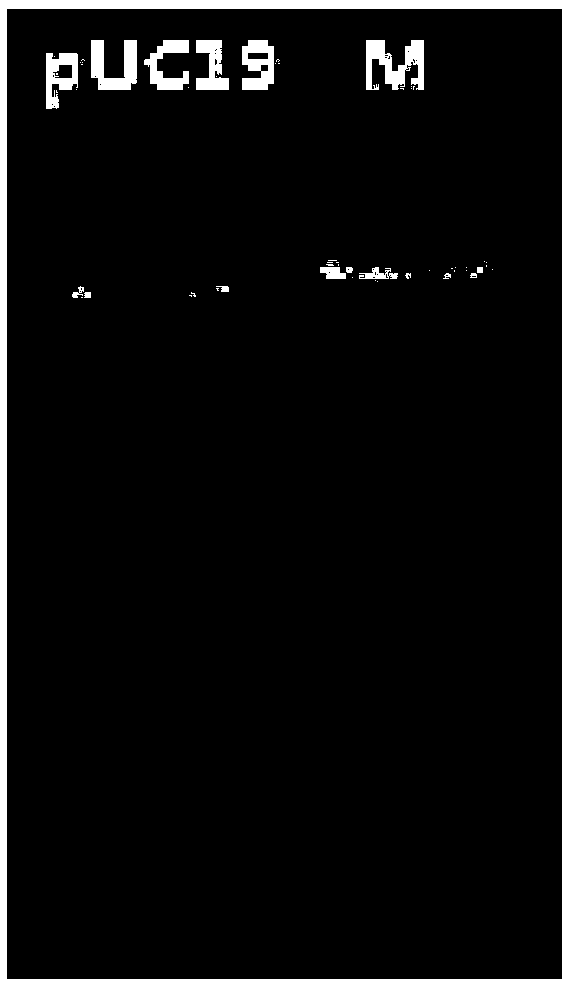Application and seamless cloning method of DNA exonuclease
A seamless cloning and exonuclease technology, applied in the field of molecular biology, can solve the problems of low recovery efficiency, increased cost, high false positive, etc., and achieve the effect of high enzyme cutting efficiency
- Summary
- Abstract
- Description
- Claims
- Application Information
AI Technical Summary
Problems solved by technology
Method used
Image
Examples
Embodiment 1
[0063] 1. Linearization of the cloning vector
[0064] According to the gene sequence of the pUC19 plasmid, the synthetic PUC19-F primer and PUC19-R primer were used for PCR amplification. The PCR used the company's high-fidelity amplification system (E035, Novoprotein), and the reaction system was prepared according to the requirements of the instructions.
[0065] The synthetic primer sequences are as follows:
[0066] PUC19-F:GAATTCACTGGCCGTCGTTTTACAACGTCGTGACTGGGAAAACCCTG;
[0067] PUC19-R: GTCGACCTGCAGGCATGCAAGCTTGGCGTAATCATGGTCATAG.
[0068] PCR reaction conditions were: step ① 94 degrees Celsius for 5 minutes; step ② 94 degrees Celsius for 20 seconds, 55 degrees Celsius for 20 seconds, 72 degrees Celsius for 90 seconds, 30 cycles; step ③ 72 degrees Celsius for 5 minutes. The PCR product was recovered and detected by 1% agarose gel electrophoresis to obtain a single band of the correct size, such as figure 1 .
[0069] 2. Obtaining the target DNA fragment
[0070] A...
Embodiment 2
[0088] 1. Linearization of the cloning vector
[0089] According to the gene sequence of the pUC19 plasmid, the synthetic PUC19-F primer and PUC19-R primer were used for PCR amplification. The PCR used the company's high-fidelity amplification system (E035, Novoprotein), and the reaction system was prepared according to the requirements of the instructions.
[0090] The synthetic primer sequences are as follows:
[0091] PUC19-F: GAATTCACTGGCCGTCGTTTTACAACGTCGTGACTGGGAAAACCCTG’
[0092] PUC19-R:
[0093] GTCGACCTGCAGGCATGCAAGCTTGGCGTAATCATGGTCATAG
[0094] PCR reaction conditions were: step ① 94 degrees Celsius for 5 minutes; step ② 94 degrees Celsius for 20 seconds, 55 degrees Celsius for 20 seconds, 72 degrees Celsius for 90 seconds, 30 cycles; step ③ 72 degrees Celsius for 5 minutes. The PCR product was recovered and detected by 1% agarose gel electrophoresis to obtain a single band with the correct size (such as Figure 5 ).
[0095] 2. Obtaining the target DNA fragme...
Embodiment 3
[0114] 1. Linearization of the cloning vector
[0115] According to the gene sequence of the pUC19 plasmid, the synthetic PUC19-F primer and PUC19-R primer were used for PCR amplification. The PCR used the company's high-fidelity amplification system (E035, Novoprotein), and the reaction system was prepared according to the requirements of the instructions.
[0116] The synthetic primer sequences are as follows:
[0117] PUC19-F: GAATTCACTGGCCGTCGTTTTACAACGTCGTGACTGGGAAAACCCTG’
[0118] PUC19-R:
[0119] GTCGACCTGCAGGCATGCAAGCTTGGCGTAATCATGGTCATAG
[0120] PCR reaction conditions were: step ① 94 degrees Celsius for 5 minutes; step ② 94 degrees Celsius for 20 seconds, 55 degrees Celsius for 20 seconds, 72 degrees Celsius for 90 seconds, 30 cycles; step ③ 72 degrees Celsius for 5 minutes. The PCR product was recovered and detected by 1% agarose gel electrophoresis to obtain a single band with the correct size (such as Figure 9 ).
[0121] 2. Obtaining the target DNA fragme...
PUM
 Login to View More
Login to View More Abstract
Description
Claims
Application Information
 Login to View More
Login to View More - R&D Engineer
- R&D Manager
- IP Professional
- Industry Leading Data Capabilities
- Powerful AI technology
- Patent DNA Extraction
Browse by: Latest US Patents, China's latest patents, Technical Efficacy Thesaurus, Application Domain, Technology Topic, Popular Technical Reports.
© 2024 PatSnap. All rights reserved.Legal|Privacy policy|Modern Slavery Act Transparency Statement|Sitemap|About US| Contact US: help@patsnap.com










